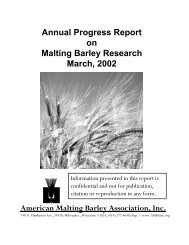Annual Progress Report on Malting Barley Research March, 2007
Annual Progress Report on Malting Barley Research March, 2007
Annual Progress Report on Malting Barley Research March, 2007
Create successful ePaper yourself
Turn your PDF publications into a flip-book with our unique Google optimized e-Paper software.
Introducti<strong>on</strong><br />
There is general agreement that in germinating barley, the degradati<strong>on</strong> of starch<br />
and producti<strong>on</strong> of fermentable sugars results from the c<strong>on</strong>certed acti<strong>on</strong> of four<br />
carbohydrases - α-amylase, β-amylase, α-glucosidase and limit dextrinase. Compared<br />
to the extensive body of knowledge about barley α- and β-amylases, there is <strong>on</strong>ly<br />
rudimentary knowledge available about α-glucosidase and limit dextrinase. This<br />
research was c<strong>on</strong>ducted to increase our fundamental knowledge of α-glucosidases in<br />
germinating barley seeds by examining the genes that encode these enzymes and by<br />
characterizing the functi<strong>on</strong>al properties of the α-glucosidases that are expressed in<br />
germinating barley seeds.<br />
α-Glucosidases are a diverse group of enzymes that catalyze several reacti<strong>on</strong>s<br />
and are capable of using a wide variety of substrates. One feature that all α-<br />
glucosidases share is the ability to hydrolytically remove the terminal m<strong>on</strong>osaccharide<br />
from the n<strong>on</strong>-reducing end of a carbohydrate. Plant α-glucosidases have been<br />
reported to hydrolyze di, - oligo- and polysaccharides, soluble starch, starch granules<br />
with intact crystalline structure, and the carbohydrate structures attached to<br />
glycoproteins. They can hydrolyze α-D-glycosidic b<strong>on</strong>ds with –1,1-, -1,2-, -1,3-, 1,4-,<br />
and -1,6- linkages. Plant α-glucosidases can hydrolyze glycosidic b<strong>on</strong>ds between<br />
glucose residues, between glucose and fructose residues, between glucose and<br />
mannose residues, and between xylose residues. Additi<strong>on</strong>ally, they can catalyze<br />
hydrolytic, c<strong>on</strong>densati<strong>on</strong> and transglycosylati<strong>on</strong> reacti<strong>on</strong>s.<br />
All plant α-glucosidases sequenced as of this time are categorized as members<br />
of the glycosyl hydrolase family 31. In most cases this categorizati<strong>on</strong> is based up<strong>on</strong><br />
sequence similarity al<strong>on</strong>e as enzyme functi<strong>on</strong> has not yet been determined. All<br />
members of the glycosyl hydrolase family 31 share the same active site sequence and<br />
have at least <strong>on</strong>e additi<strong>on</strong>al highly c<strong>on</strong>served regi<strong>on</strong>. The first α-glucosidase cl<strong>on</strong>ed<br />
from a plant was in 1996 when Dr. R<strong>on</strong> Skadsen’s lab cl<strong>on</strong>ed Agl1 from barley (Tibbot<br />
and Skadsen, 1996). Since that time, other genes encoding α-glucosidases have been<br />
identified in plants although, in almost all cases, more is known about the gene than the<br />
116
















